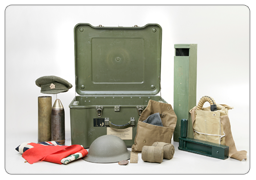Holding history in your hands
January 6, 2014
A small periscope, a rough-looking khaki cap, an old-fashioned steel helmet, a copy of a letter home. Think of them as history you can hold in your hand.
The year 2014 marks the 100th anniversary of the start of the First World War, a conflict that would last four and a half years and claim the lives of approximately 10 million combatants, 65,000 of whom were Canadian.
The Canadian War Museum’s Supply Line project will help today’s students get in touch on a personal level — literally — with this key event in their nation’s history and to reflect upon the war’s impact on the people who experienced it and on Canada as a whole.
As Learning Specialist Sandra O’Quinn puts it, the Supply Line project will “get outside the museum walls and into the schools.” The kits sent out to participating schools will each include between 15 and 20 objects tied to Canada’s involvement in the First World War, together with reproductions of maps, photographs and letters. While some of the items will be genuine artifacts from the war, others are high-quality reproductions created by the Museum or sourced from specialized makers.
Creating the kits is a “daunting project,” explains O’Quinn, who is currently working with European partners to obtain actual materials retrieved from First World War battlefields where Canadians fought.
Each kit will be accompanied by historical information explaining the objects, their use and significance. It will also offer lesson plans and links to the extensive historical resources available through the Museum website. The Supply Line kits will help teachers bring classroom lessons alive or add an extra dimension to schools’ Remembrance Day commemoration activities.
“You can tell stories through the objects,” says O’Quinn, giving the example of a small metal shrapnel ball. The tiny ball may not look like much when you hold it in your hand. But once you learn that high-explosive shells were packed with hundreds of these shrapnel projectiles, you appreciate why armies in the First World War sought shelter in the trenches. Authentic pieces made by soldiers, such as trench art created from discarded shell casings, will show students a personal dimension of life at the front.
“People want to touch things, pick them up and hold them,” O’Quinn explains. “We hope that they’ll feel a connection with the past when they hold a bit of history in their hands.”